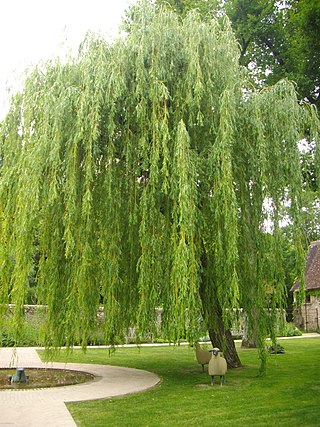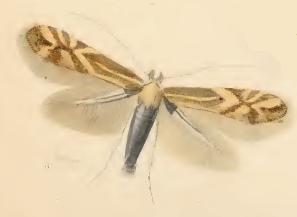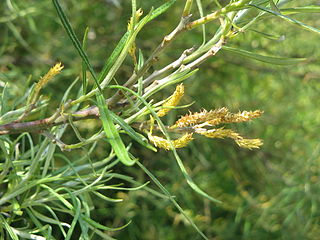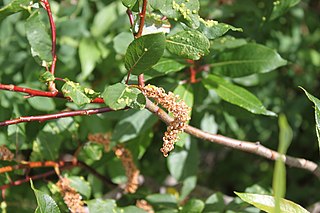
Willows, also called sallows and osiers, of the genus Salix, comprise around 350 species of typically deciduous trees and shrubs, found primarily on moist soils in cold and temperate regions.

Salix caprea, known as goat willow, pussy willow or great sallow, is a common species of willow native to Europe and western and central Asia.

Salix × fragilis, with the common names crack willow and brittle willow, is a hybrid species of willow native to Europe and Western Asia. It is native to riparian habitats, usually found growing beside rivers and streams, and in marshes and water meadow channels. It is a hybrid between Salix euxina and Salix alba, and is very variable, with forms linking both parents.

Salix babylonica is a species of willow native to dry areas of northern China, but cultivated for millennia elsewhere in Asia, being traded along the Silk Road to southwest Asia and Europe.

Euphorbia myrsinites, the myrtle spurge, blue spurge, or broad-leaved glaucous-spurge, is a succulent species of flowering plant in the spurge family Euphorbiaceae.

Salix nigra, the black willow, is a species of willow native to eastern North America, from New Brunswick and southern Ontario west to Minnesota, and south to northern Florida and Texas.

Salix myrsinifolia, known as the dark-leaved willow or myrsine-leaved willow, is a species of willow native to Europe and Western Siberia. It forms a 2–5 m (6.6–16.4 ft) high shrub. In the north it often becomes a tree up to 8 m (26 ft) tall.

The United Kingdom, being in the British Isles, is ideal for tree growth, thanks to its mild winters, plentiful rainfall, fertile soil and hill-sheltered topography. In the absence of people, much of Great Britain would be covered with mature oaks, except for Scotland. Although conditions for forestry are good, trees do face damage threats arising from fungi, parasites and pests. The development of afforestation and the production and supply of timber in Wales come under Natural Resources Wales, as set out in the Forestry Act 1967.

Phyllonorycter salictella is a moth of the family Gracillariidae. It is known from all of Europe, east to Russia and Japan.

Agonopterix arctica is a moth of the family Depressariidae. It is found in Fennoscandia and northern Russia.

Vaccinium myrsinites is a species of flowering plant in the heath family known by the common name shiny blueberry. It is native to the southeastern United States from Alabama, Georgia, South Carolina and Florida. It may occur as far west as Louisiana.

Salix humboldtiana, called Humboldt's willow, is a tree species of willow native to North and South America, growing along watercourses. Some authorities consider it a synonym of Salix chilensis, which Molina described in 1782. Willdenow described Salix humboldtiana in 1805.

Rabdophaga salicis is a gall midge which forms galls on sallows. It was first described by Franz von Paula Schrank in 1803.

Salix repens, the creeping willow, is a small, shrubby species of willow in the family Salicaceae, growing up to 1.5 metres in height. Found amongst sand dunes and heathlands, it is a polymorphic species, with a wide range of variants. In the UK, at least, these range from small, prostrate, hairless plants at one end of the spectrum to taller, erect or ascending silky-leaved shrubs at the other. This wide variation in form has resulted in numerous synonyms.

Salix pedicellata is a species of willow. It is a shrub or small tree to about 6–8 m tall, native around the Mediterranean Sea from Portugal to Lebanon and Syria in the north and from the Canary Islands to Tunisia in the south. Salix canariensis may be treated as a subspecies of S. pedicellata.
Euura myrsiniticola is a species of sawfly belonging to the family Tenthredinidae. The larvae feed internally in a gall formed on the leaves of whortle-leaved willow.

Salix rosmarinifolia is a species of flowering plant belonging to the family Salicaceae.
Lebetanthus is a genus of flowering plants belonging to the family Ericaceae.

Salix euxina, the eastern crack-willow, is a species of flowering plant in the willow family Salicaceae, native from Turkey to the Caucasus. It was first described by I. V. Belyaeva in 2009. It is one of the parents of the common crack-willow, Salix × fragilis.

Salix pyrifolia, the balsam willow, is a species of flowering plant in the family Salicaceae, native to Canada, and the north-central to northeastern United States. A shrub, its leaves emit a balsam-like fragrance. It is available from commercial suppliers.

















